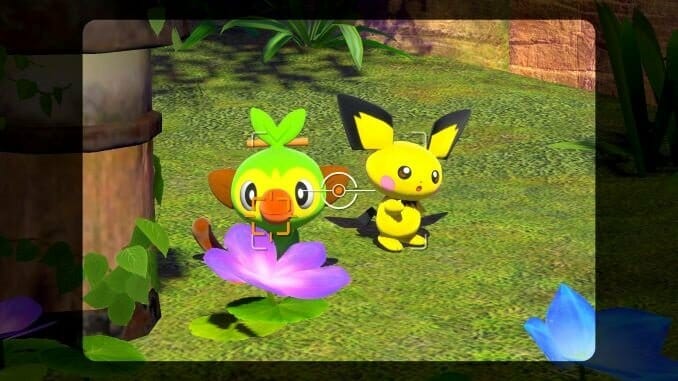
If I were to show my New Pokémon Snap gallery to my high school photography teacher, I do not think he would be pleased. Holly, he would say, you forgot the rule of thirds, this lighting is terrible, and why does your subject’s face take up most of the photo? Then he would shake his head at me like Professor Oak, reward me 0 points, and suggest that I try again. If my New Pokémon Snap photos were of anything other than rare Pokémon, they’d be supremely disappointing.
But in New Pokémon Snap, those same criteria might award me its system’s highest honor. It seems to them, my “best” photos are ones that are mostly taken up by a Pokémon’s face. I understand why this is. After all, the goal is less about taking a good picture, and more about documenting the existence and behaviors of the Pokémon, technique be damned. The images that will get you the most points, or elevate its reward tier on the 1-4 star scale, are those that capture Pokémon in increasingly rare scenarios, like sleeping, dancing, or reacting to being hit in the face with a Fluffruit. While this is effective for the game’s safari-on-rails format and captures the spirit of wildlife photography, it’s a shame if your values are broader. It’s almost crushing to get a low score on the pictures that take into account criteria like framing, depth of field, contrast, texture, and lighting.
Then again, photography, like any form of art, is a subjective medium. When it came to the photo’s grading system, the developers of New Pokémon Snap had a challenge on their hands. An algorithm-based detection system can confirm patterns but is doomed to lack the nuance that comes from the filter of human experience. And there’s no way an actual person could individually grade them all. Even if they could, the opinions would be wildly inconsistent and subject to debate, opening up all kinds of unintended conflict. The simplicity of the system, however reductive, is a small sacrifice for the game’s ability to exist at all.
Of course, I’m being facetious, in that it doesn’t actually matter if New Pokémon Snap knows how to assess a good photo. It’s a game for kids that lets you put stickers and faces on your photos. A few dozen hours in a videogame isn’t enough to erase years of practice and skill I’ve already put into the hobby. No one’s sifting through my gallery for the next Pulitzer Prize winner, anyway.
Plus, there are a few positive things a budding young photographer can take away from New Pokémon Snap or videogames in general. A lot of games have a photo mode these days, and some of them even offer the basic tools of a good camera while adding tweaks inspired and enabled by the digital format. The Fallout 76 photo mode, for example, seems to build on some of the photo-taking tricks used by players in earlier games on the PC, swapping out the camera detaching console code for tools that let them zoom in and out, adjust the depth of field, or even tweak color intensity and lighting or add a picture frame. It’s not sophisticated, but hey, practice is practice, and fiddling around with the tools gives the player a chance to compare what works visually in a risk-free space.
Similarly, New Pokémon Snap has its strengths despite the format’s limitations. What I like about the game is that it keeps me on my toes. Wildlife photography requires supernatural levels of patience and a hair-trigger intensity that matches the speed of its subjects. And while I wouldn’t call New Pokémon Snap a master course in photographic reflexes, it’s at least a lesson in staying at the ready.
The spontaneity of New Pokémon Snap should be celebrated. What it lacks in realism it makes up for by recreating that same thrill of discovery found in the base series. The photography tools, like the Fluffruits, the Melody Player and the Illumina Orbs, might be fantastic inventions but combined with the sheer number of Pokémon, they create an entire ecosystem of possible rare sightings that make it more fun than the real thing. Sure, the game might think my masterpiece photos are absolute garbage. But despite Professor Mirror’s limited eye for technique, every picture feels like a reward.
Holly Green is the editor-at-large of Paste Games and a reporter and semiprofessional photographer. She is also the author of Fry Scores: An Unofficial Guide To Video Game Grub. You can find her work at Gamasutra, Polygon, Unwinnable, and other videogame news publications.